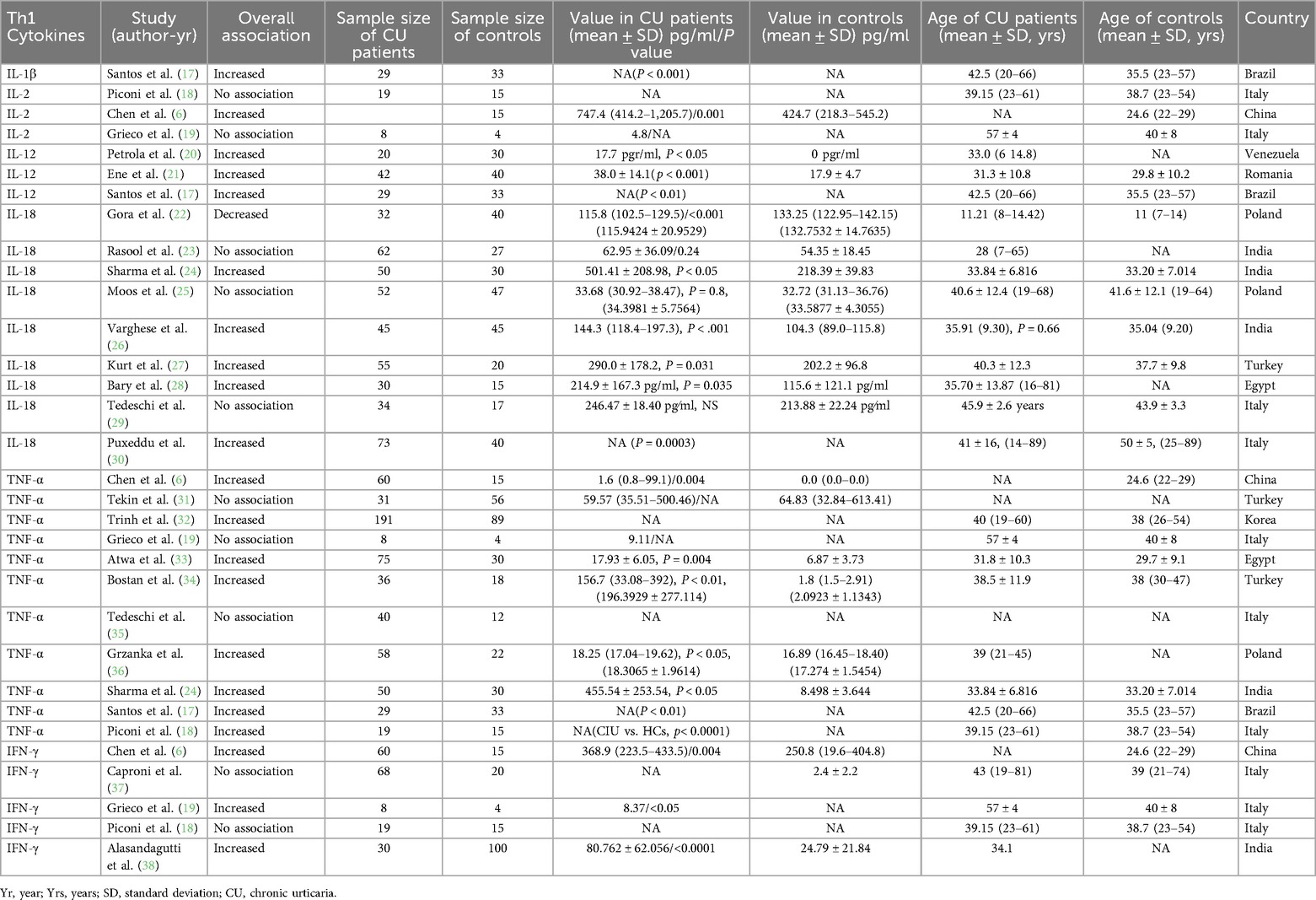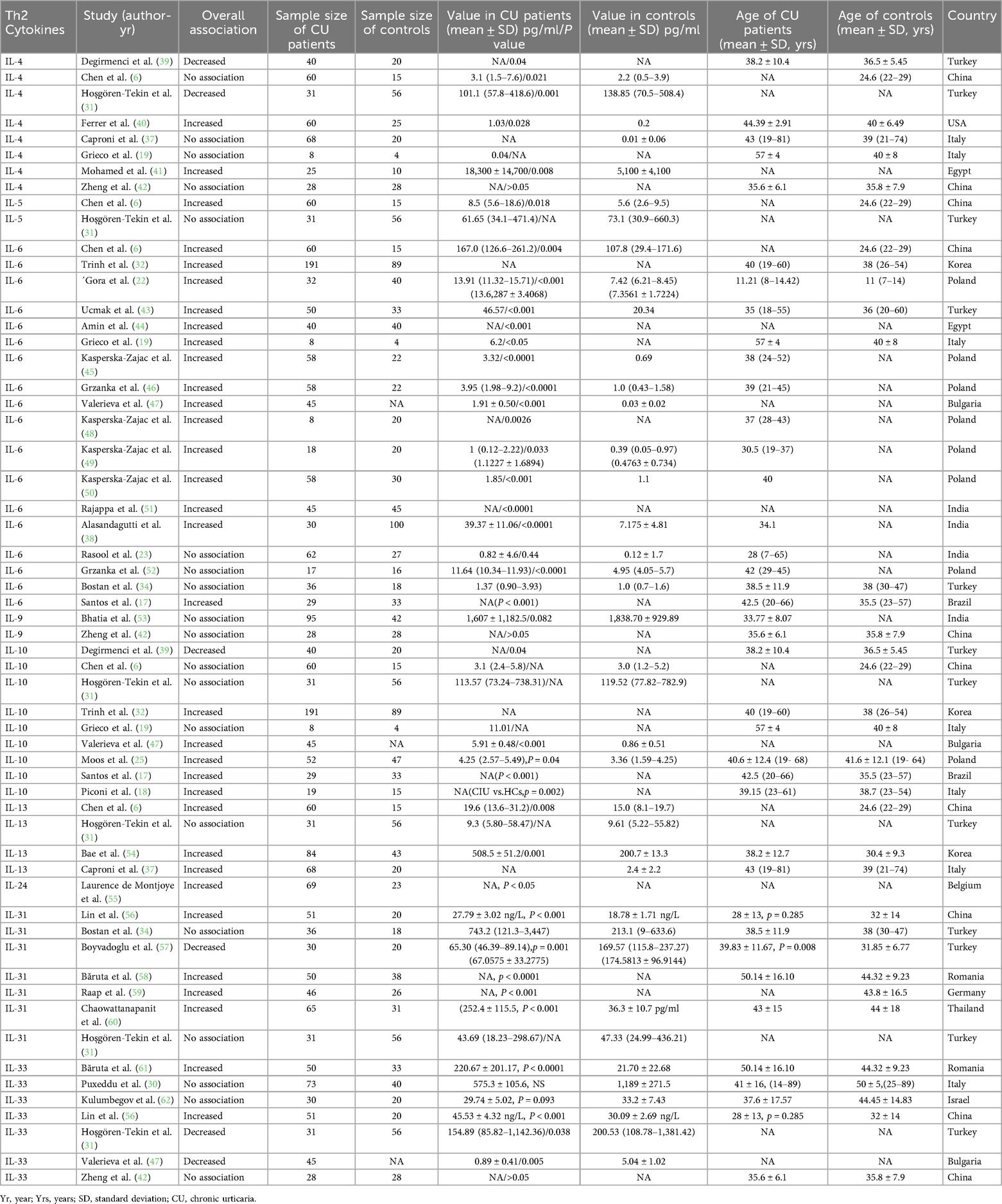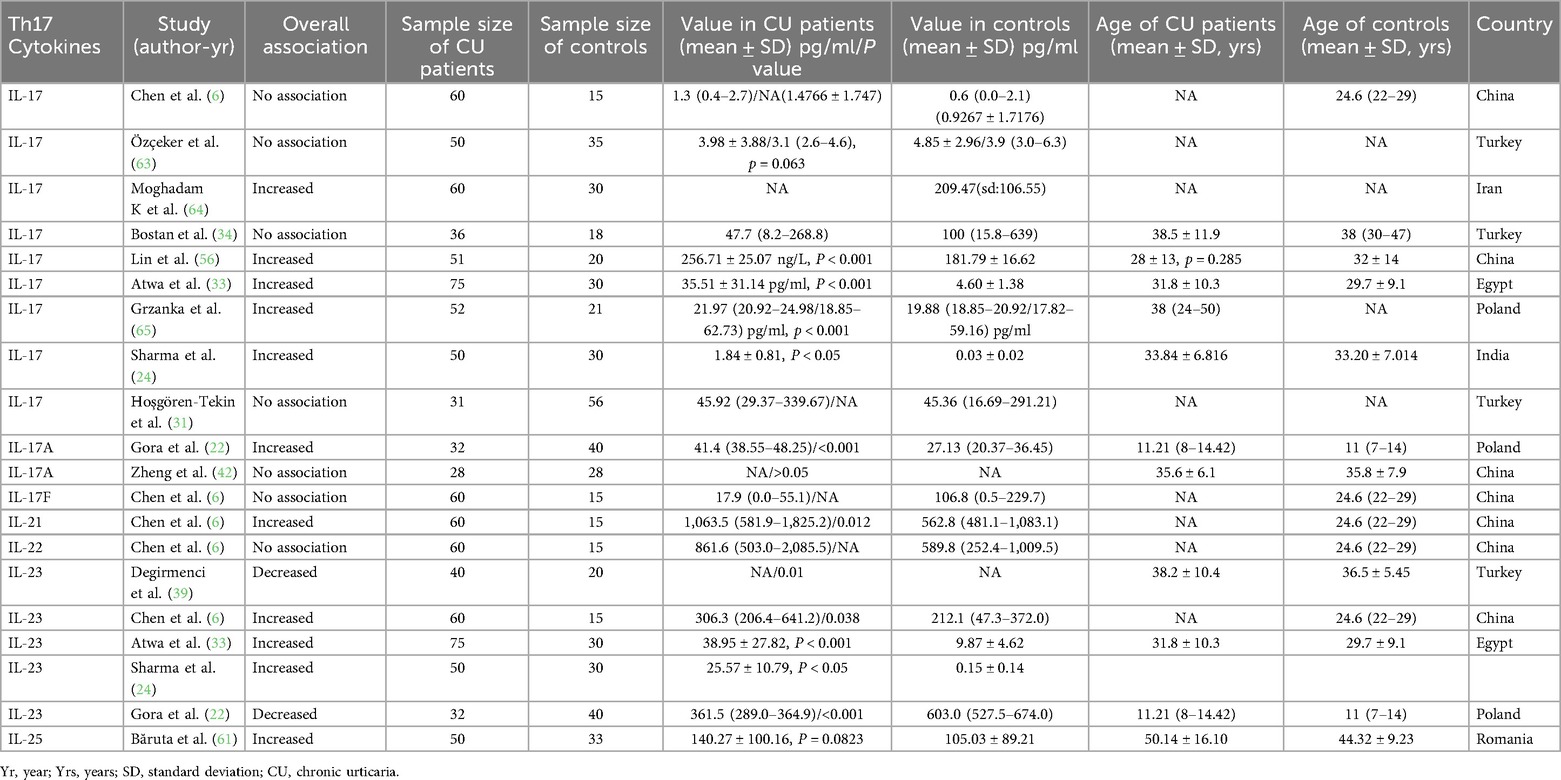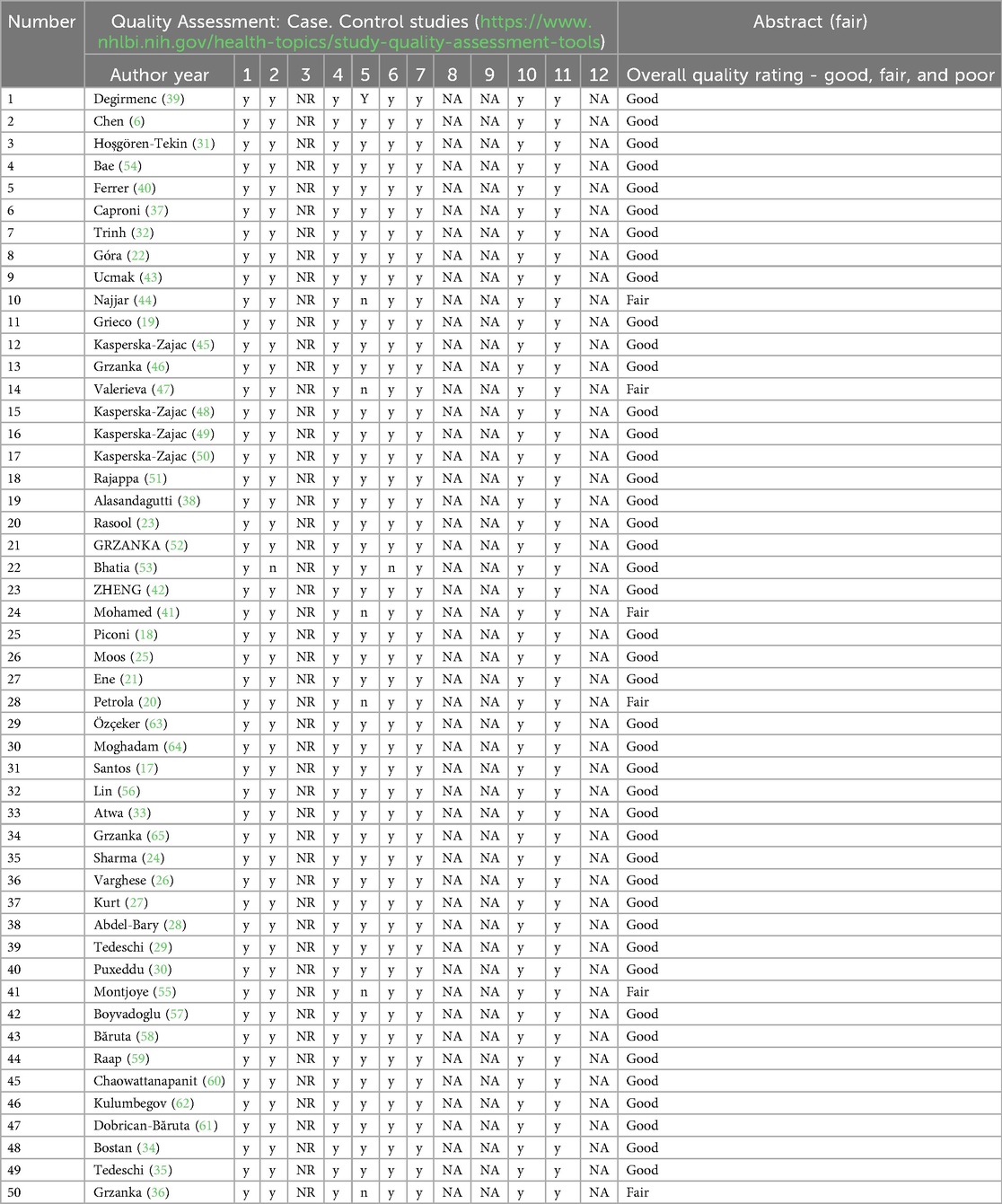- 1Department of Dermatology, Beijing Tsinghua Changgung Hospital, School of Clinical Medicine, Tsinghua Medicine, Tsinghua University, Beijing, China
- 2Photomedicine Laboratory, Institute of Precision Medicine, Tsinghua University, Beijing, China
Objectives: To conduct a systematic review and meta-analysis to identify Th1-, Th2, and Th17 related serum biomarkers that reflect disease activity in chronic urticaria (CU), thereby enhancing the assessment of disease activity in both trials and clinical practice.
Methods: Systematic searches of PubMed, EMBASE, and Web of Science were conducted through November 2024 to identify articles reporting the associations between CU and serum biomarkers. Serum Th1, Th2, and Th17 related biomarkers were identified in CU patients and correlated with disease severity and patient characteristics (ex. Age, sex, and comorbidities). The study quality was assessed using the National Heart, Lung, and Blood Institute Quality Assessment Tool for case-control studies. Meta-analysis was performed using the random-effects model with Hedges' g to pool standardized mean differences (SMDs). For meta-analysis, data were included for biomarkers reported in at least four studies with available means and standard deviations (SDs). Data reported as medians with ranges or interquartile ranges (IQRs) were evaluated for skewness. If the data were found to be significantly skewed, the means and SDs were not calculated. Conversely, if the data were not skewed, the means and SDs were estimated using validated methods.
Results: A total of 6,013 studies were screened, of which 50 were included, reporting 22 serum Th1, Th2, and Th17 related cytokines. Meta-analyses revealed significant pooled standardized mean differences (SMDs) for serum TNF-α and IL-17.
Conclusions: Serum TNF-α and IL-17 levels are significantly increased in patients with CU compared to healthy age- and sex-matched controls. These findings have the potential to influence clinical guidelines for the diagnostic workup of CU to include testing the serum levels of TNF-α and IL-17.
1 Introduction
Chronic urticaria (CU) is a common and debilitating mast cell-driven skin disease that persists for over 6 weeks, and is characterized by wheals, angioedema, or both (1). The underlying pathophysiology of CU remains poorly understood. While a central role for mast cells has traditionally been proposed, growing evidence suggests that immune dysregulation mediated by T lymphocytes also plays a significant role (2).
The activity of T lymphocytes largely depends on the differentiation of CD4+ T cells into distinct functional subsets, such as Th1, Th2, Th17, and T follicular helper (Tfh) cells, mediated by specific cytokine production (3). A complex network of cytokines released by Th cells into the peripheral circulatory microenvironment are thought to influence the immune response in CU (4–7).
Th1 cells produce cytokines such as IL-1β, IL-2, IL-12, IL-18, IFN-γ, and tumor necrosis factor (TNF), and are involved in cell-mediated pro-inflammatory responses (8). Th2 cells secrete cytokines like IL-4, IL-5, IL-6, IL-9, IL-10, IL-13, IL-17E, IL-31, and IL-33, which can inhibit Th1 cytokine production (9). Th2 cytokines are involved in antibody responses, particularly IgE production, and activate eosinophils and mast cells (10, 11). The imbalance between Th1 and Th2 has long been considered a potential mechanism in urticaria (12, 13). Th17 cells, which produce IL-17, IL-17A, IL-17F, IL-21, IL-22, IL-23, IL-25, and transforming growth factor (TGF)-β, are implicated in the pathogenesis of autoimmune and allergic diseases (14, 15).
In this study, we aimed to better characterize the helper T-cell immune phenotype in CU patients. The clinical roles of serum Th1, Th2, and Th17 cytokines in CU patients are discussed in this systematic review.
2 Methods
2.1 Literature search strategy
We systematically searched PubMed, EMBASE, and Web of Science from inception to November 2024. The protocol was registered in PROSPERO (CRD42024608505). Eligible studies quantified serum cytokines in chronic urticaria (CU). The search strategy combined Medical Subject Headings and free-text terms for CU (“Chronic Urticaria”, “Chronic Spontaneous Urticaria”, “Idiopathic Chronic Urticaria”, “Autoimmune Urticaria”, and “Chronic Autoimmune Urticaria”) with terms for biomarkers (“Biomarkers”, “Biologic Markers”, “Clinical Marker”, “Serum Markers”, “Cytokines”, “Chemokines”, and “Inflammation Mediators”).
2.2 Eligibility criteria
We included original research articles that compared serum levels of Th1-, Th2, and Th17 related cytokines between CU patients and healthy controls and examined associations with disease presence, activity, or severity. We excluded case reports, animal studies, editorials, letters, and studies that exclusively measured biomarkers in tissue biopsies, lymphocyte subsets, or genetic polymorphisms.
2.3 Study selection and data extraction
The outcome was the identification and correlation of cytokine levels with CU. Two reviewers (JWX and CHS) independently screened titles, abstracts, and full texts using EndNote. Discrepancies were resolved by a third reviewer (YZ). Data were extracted and verified by JWX and CHS. The author lists and publication years were screened to exclude possible duplicate or overlapping studies. The extracted variables included study characteristics, patient demographics (age and sex), biomarker levels, and reported associations with disease activity or severity, along with p-values. If any data were incomplete or unclear, the corresponding authors of the selected studies were contacted for further detail.
2.4 Quality evaluation
Study quality was assessed using the National Heart, Lung, and Blood Institute (NHLBI) Quality Assessment Tools, which are applicable to cohort, cross-sectional, case-control, and case series studies. This systematic review was conducted in accordance with the Preferred Reporting Items for Systematic Reviews and Meta-Analyses (PRISMA) guidelines. JWX and CHS drafted the manuscript. All authors contributed to the development of the selection criteria and the data extraction protocols. All the authors have read and approved the final manuscript.
2.5 Statistical analysis
Meta-analyses were performed using the random-effects model with Hedges' g to account for small-sample bias and between-study heterogeneity. Pooled standardized mean differences (SMDs) were calculated for biomarkers reported in at least four studies with available means and standard deviations (SDs). Studies were excluded from the meta-analysis if: (1) biomarker levels were reported as undetectable; (2) SDs were not reported or calculable; (3) data were presented only as medians with ranges or interquartile ranges (IQRs) and were determined to be skewed upon inspection. Data skewness was evaluated for studies that reported medians with IQRs or ranges. If not significantly skewed, means and SDs were estimated using validated methods (16). When applicable, 95% confidence intervals or ranges were used to back-calculate the SDs.
3 Results
A total of 6,013 studies were screened, of which 50 were included, reporting 22 serum Th1-, Th2, and Th17 related cytokines (Figure 1: PRISMA flow diagram). Meta-analyses revealed significant pooled SMDs for serum TNF-α and IL-17.
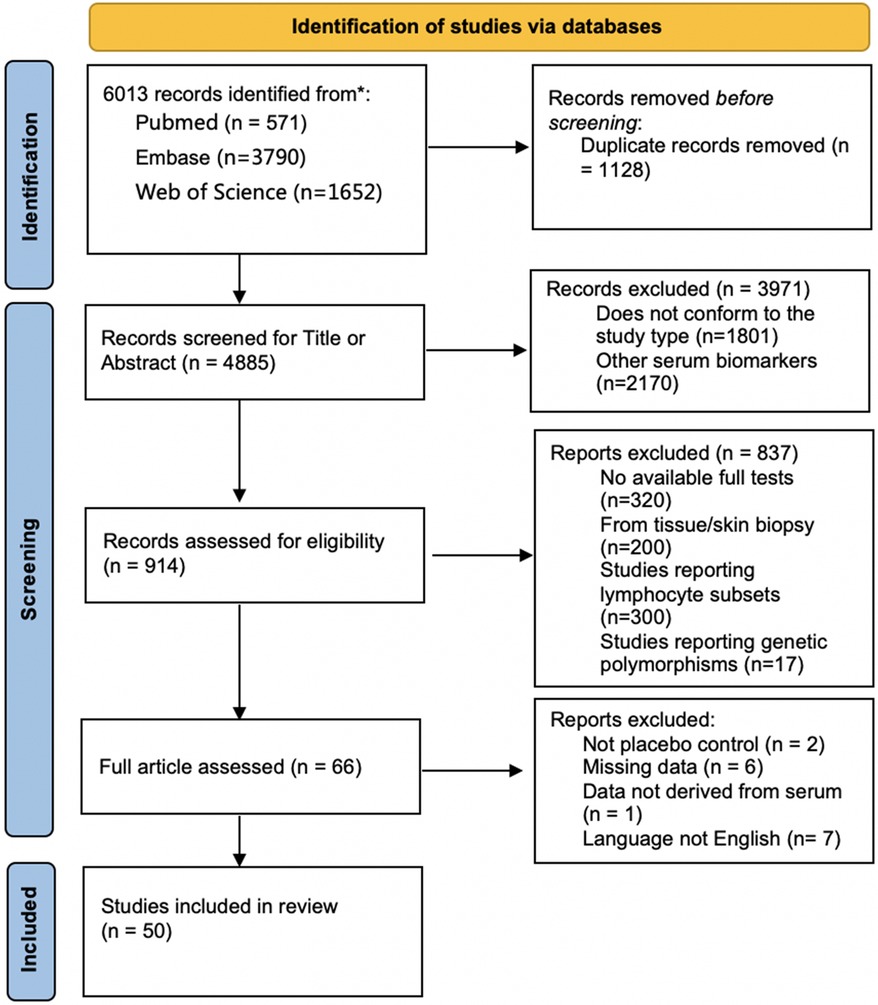
Figure 1. PRISMA (Preferred Reporting of Items in Systematic Reviews and Meta-Analysis) flowchart depicting the identification, screening, and inclusion of the studies included.
3.1 Th1 cytokines
IL-18 was the most frequently assessed Th1-related cytokine in nine studies. Of these, five studies reported elevated IL-18 levels in CU patients compared to controls, one study described a reduction, and three studies found no significant difference. A pooled analysis of seven studies involving 511 participants yielded a standardized mean difference (SMD) of 0.55 (95% CI, −0.11–1.22), indicating considerable variation among study results (Figure 2A). TNF-α levels were examined in 11 studies. Eight studies identified increased serum levels in CU patients, while the remaining three reported no association. Meta-analysis of four studies with 319 participants showed a significant difference, with a pooled SMD of 1.40 (95% CI, 0.59–2.21) (Figure 2B). IFN-γ levels were evaluated in five studies. Three of these studies observed higher levels in CU patients than in healthy controls, and two did not find a statistically significant difference. IL-12 was reported in three studies, all of which documented elevated levels in CU patients relative to the control groups. IL-2 levels were measured in three studies. One study identified increased IL-2 concentrations in CU patients, while two reported no such association (Table 1). IL-1β was included in one study, which observed higher serum levels in the CU group than in the controls (Table 1).
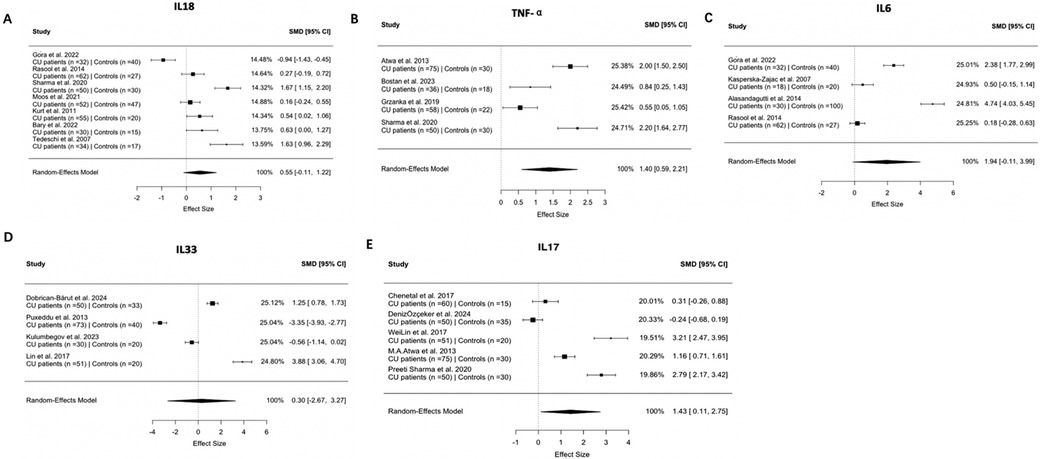
Figure 2. Forest plot for the comparison of (A) serum IL-18, (B) TNF-α, (C) IL-6, (D) IL-33, and (E) IL-17 cytokines in chronic urticaria patients vs. healthy control. The forest plot was generated using the random-effects model with Hedges' g to account for small-sample bias and between-study heterogeneity. SMD = standardized mean difference in the concentrations of serum biomarkers between groups.
3.2 Th2 cytokines
Among the Th2 cytokines, IL-6 was the most frequently studied, as reported in 18 articles. Fifteen studies observed elevated IL-6 levels in CU patients compared to healthy controls, while three studies reported no association. A meta-analysis based on four studies involving 329 participants indicated a pooled SMD of 1.94 (95% CI, −0.11–3.99), suggesting a trend toward elevation without reaching statistical significance (Figure 2C). IL-4 levels were investigated in eight studies. Two studies documented increased IL-4 levels in CU patients, two reported reduced levels, and four found no significant association (Table 2). IL-5 expression was examined in two studies. One study recorded higher levels in CU patients than in controls, and another found no difference (Table 2). IL-10 was reported in nine studies. Among these, five studies observed increased levels in CU patients, one study noted a decrease, and three reported no association (Table 2). IL-13 levels were evaluated in four studies. Three studies reported elevated IL-13 levels in CU patients, and one study showed no statistically significant difference (Table 2). IL-31 was included in seven studies. Four studies identified higher IL-31 levels in CU cases than in controls, one study reported reduced levels, and two studies found no association (Table 2). IL-33 has also been reported in seven studies. Two studies observed increased IL-33 levels in CU patients, two reported lower levels, and three studies did not identify a significant difference (Table 2). A meta-analysis of four studies with 317 participants revealed a pooled SMD of 0.30 (95% CI, −2.67–3.27) (Figure 2D). IL-9 levels were measured in two studies, both of which found no significant differences between CU patients and controls (Table 2). IL-24 was investigated in one study that reported higher levels in the CU group than in the control group (Table 2).
3.3 Th17 cytokines
A meta-analysis of five studies involving 416 participants demonstrated a significant elevation in serum IL-17 levels among patients with chronic urticaria, with a pooled SMD of 1.43 (95% CI, 0.11–2.75) (Figure 2E). IL-17 was evaluated across nine studies; five of them identified increased levels in CU cases compared to controls, while the remaining four studies reported no statistically significant association (Table 3). Two studies investigated IL-17A concentration. Among them, one study documented elevated serum IL-17A levels in CU patients relative to controls, and another study found no significant difference between groups (Table 3). IL-17F was measured in one study, which indicated no notable difference in serum levels between CU and control cohorts (Table 3). IL-21 was reported in one study that observed higher levels in CU patients than in healthy controls (Table 3). IL-22 was included in one publication, with results showing no measurable differences between groups (Table 3). Five studies assessed the IL-23 levels. Of these, three studies observed elevated IL-23 concentrations in CU patients and two studies did not detect a meaningful difference when compared with controls (Table 3). IL-25 was included in one study that reported increased serum levels in the CU group compared to the control group (Table 3).
3.4 Quality assessment
Assessment of study quality using the NHLBI Quality Assessment Tool for Case-Control Studies indicated that 44 of the 50 included studies (88%) were rated as high quality with a low risk of bias, while the remaining 6 studies (12%) were considered to have a moderate risk of bias (Table 4).
4 Discussion
To our knowledge, this systematic review represents the first registered evaluation of serum Th1, Th2, and Th17 cytokines in patients with CU. Our meta-analysis revealed statistically significant pooled SMDs values for serum TNF-α and IL-17 levels. These findings may influence the clinical practice for CU patients, as measurements of serum TNF-α and IL-17 levels are accessible to some clinicians.
Tumor necrosis factor alpha (TNF-α) plays a critical role in inflammation, immune regulation, and apoptosis (36). It is released by human skin mast cells and other inflammatory cells present at urticarial lesion sites (66), making it a candidate mediator in urticaria pathogenesis (34). Our meta-analysis revealed a significant association between CU and elevated serum TNF-α levels, with a pooled SMD of 1.40 (95% CI of 0.59–2.21). This significant link confirms the autoimmune and inflammatory nature of CU, and supports the inclusion of TNF-α in the clinical assessment of CU.
IL-17, produced by T helper (Th) type 17 cells, binds to IL-17 receptors on epithelial, endothelial, and fibroblastic stromal cells (63). IL-17 is associated with many autoimmune disorders, such as psoriasis, multiple sclerosis, inflammatory bowel disease, rheumatoid arthritis, and asthma (67–69). Serum IL-17 levels were significantly elevated in CU patients compared to controls and correlated with urticaria severity (24, 33, 70) Our meta-analysis confirmed this, showing a significant pooled SMD of 1.43 (95% CI of 0.11–2.75). These findings support IL-17 as a valuable biomarker for CU clinical assessment.
A limitation of this systematic review and meta-analysis is the heterogeneity in assay methods. Variability in laboratory methods across studies (e.g., ELISA, multiplex assays) may lead to variations in cytokine measurements. Furthermore, data from some studies could not be pooled because of non-normal data distribution. In addition, owing to the limited number of related studies, we did not differentiate between chronic induced urticaria and chronic spontaneous urticaria in this review despite their distinct pathogenic mechanisms. The lack of subgroup analysis might restrict the clinical applicability of our findings.
Despite these limitations, the results of this review and meta-analysis provide high-quality evidence-based insights into the associations between serum Th1, Th2, and Th17 cytokines and CU. In conclusion, Th1 and Th17-derivated cytokines play crucial roles in the pathogenesis of CU. CU is thus characterized as a chronic inflammatory state mediated by diverse cytokines and autoimmune mechanisms. These findings may help inform clinical guidelines for CU diagnosis by incorporating serum TNF-α and IL-17 levels. However, the clinical cut-off values, sensitivity, specificity, and practical implementation of these biomarkers have not yet been explored. Therefore, well designed and large-scale studies are needed to determine the optimal cutoff levels of TNF-α and IL-17.
Author contributions
JX: Conceptualization, Formal analysis, Investigation, Methodology, Writing – original draft, Writing – review & editing. CS: Data curation, Methodology, Writing – original draft. MS: Formal analysis, Software, Writing – original draft. BL: Formal analysis, Software, Validation, Writing – original draft. YZ: Funding acquisition, Resources, Writing – review & editing.
Funding
The author(s) declare that financial support was received for the research and/or publication of this article. This work was supported by the Beijing Hospitals Authority’s Ascent Plan, Code: DFL20240901.
Conflict of interest
The authors declare that the research was conducted in the absence of any commercial or financial relationships that could be construed as a potential conflict of interest.
Generative AI statement
The authors declare that no Gen AI was used in the creation of this manuscript.
Any alternative text (alt text) provided alongside figures in this article has been generated by Frontiers with the support of artificial intelligence and reasonable efforts have been made to ensure accuracy, including review by the authors wherever possible. If you identify any issues, please contact us.
Publisher's note
All claims expressed in this article are solely those of the authors and do not necessarily represent those of their affiliated organizations, or those of the publisher, the editors and the reviewers. Any product that may be evaluated in this article, or claim that may be made by its manufacturer, is not guaranteed or endorsed by the publisher.
Supplementary material
The Supplementary Material for this article can be found online at: https://www.frontiersin.org/articles/10.3389/falgy.2025.1673041/full#supplementary-material
References
1. Zuberbier T, Ensina LF, Giménez-Arnau A, Grattan C, Kocatürk E, Kulthanan K, et al. Chronic urticaria: unmet needs, emerging drugs, and new perspectives on personalised treatment. Lancet. (2024) 404(10450):393–404. doi: 10.1016/S0140-6736(24)00852-3
2. Moy AP, Murali M, Nazarian RM. Identification of a Th2- and Th17-skewed immune phenotype in chronic urticaria with Th22 reduction dependent on autoimmunity and thyroid disease markers. J Cutan Pathol. (2016) 43(4):372–8. doi: 10.1111/cup.12673
3. Dong C. Cytokine regulation and function in T cells. Annu Rev Immunol. (2021) 39(1):51–76. doi: 10.1146/annurev-immunol-061020-053702
4. Chen WC, Chiang BL, Liu HE, Leu SJ, Lee YL. Defective functions of circulating CD4+ CD25+ and CD4+ CD25- T cells in patients with chronic ordinary urticaria. J Dermatol Sci. (2008) 51(2):121–30. doi: 10.1016/j.jdermsci.2008.02.012
5. Huilan Z, Runxiang L, Bihua L, Qing G. Role of the subgroups of T, B, natural killer lymphocyte and serum levels of interleukin-15, interleukin-21 and immunoglobulin E in the pathogenesis of urticaria. J Dermatol. (2010) 37(5):441–7. doi: 10.1111/j.1346-8138.2010.00805.x
6. Chen Q, Zhong H, Chen WC, Zhai Z, Zhou Z, Song Z, et al. Different expression patterns of plasma Th1-, Th2-, Th17- and Th22-related cytokines correlate with serum autoreactivity and allergen sensitivity in chronic spontaneous urticaria. J Eur Acad Dermatol Venereol. (2018) 32(3):441–8. doi: 10.1111/jdv.14541
7. Hofmann MA, Kiecker F, Zuberbier T. A systematic review of the role of interleukin-17 and the interleukin-20 family in inflammatory allergic skin diseases. Curr Opin Allergy Clin Immunol. (2016) 16(5):451–7. doi: 10.1097/ACI.0000000000000310
8. Dong C, Flavell RA. Th1 and Th2 cells. Curr Opin Hematol. (2001) 8(1):47–51. doi: 10.1097/00062752-200101000-00009
9. Del Prete G. The concept of type-1 and type-2 helper T cells and their cytokines in humans. Int Rev Immunol. (1998) 16(3-4):427–55. doi: 10.3109/08830189809043004
10. Shelburne CP, Ryan JJ. The role of Th2 cytokines in mast cell homeostasis. Immunol Rev. (2001) 179:82–93. doi: 10.1034/j.1600-065X.2001.790109.x
11. Pate MB, Smith JK, Chi DS, Krishnaswamy G. Regulation and dysregulation of immunoglobulin E: a molecular and clinical perspective. Clin Mol Allergy. (2010) 8(1):3. doi: 10.1186/1476-7961-8-3
12. Zhao G, Zhou S, Suo Q, Su Q. Effects of moderate and high intensity exercise on T1/T2 balance. Exerc Immunol Rev. (2012) 2012(18):98–114.
13. Ying S, Kikuchi Y, Meng Q, Kay AB, Kaplan AP. TH1/TH2 cytokines and inflammatory cells in skin biopsy specimens from patients with chronic idiopathic urticaria: comparison with the allergen-induced late-phase cutaneous reaction. J Allergy Clin Immunol. (2002) 109(4):694–700. doi: 10.1067/mai.2002.123236
14. Speeckaert R, Lambert J, Grine L, Van Gele M, De Schepper S, van Geel N. The many faces of interleukin-17 in inflammatory skin diseases. Br J Dermatol. (2016) 175(5):892–901. doi: 10.1111/bjd.14703
15. Lopes A, Machado D, Pedreiro S, Henriques A, Silva I, Tavares B, et al. Different frequencies of Tc17/Tc1 and Th17/Th1 cells in chronic spontaneous urticaria. Int Arch Allergy Immunol. (2013) 161(2):155–62. doi: 10.1159/000345401
16. Shi J, Luo D, Wan X, Liu Y, Liu J, Bian Z, et al. Detecting the skewness of data from the five-number summary and its application in meta-analysis. Stat Methods Med Res. (2023) 32(7):1338–60. doi: 10.1177/09622802231172043
17. Dos Santos JC, Azor MH, Nojima VY, Lourenço FD, Prearo E, Maruta CW, et al. Increased circulating pro-inflammatory cytokines and imbalanced regulatory T-cell cytokines production in chronic idiopathic urticaria. Int Immunopharmacol. (2008) 8(10):1433–40. doi: 10.1016/j.intimp.2008.05.016
18. Piconi S, Trabattoni D, Iemoli E, Fusi ML, Villa ML, Milazzo F, et al. Immune profiles of patients with chronic idiopathic urticaria. Int Arch Allergy Immunol. (2002) 128(1):59–66. doi: 10.1159/000058004
19. Grieco T, Porzia A, Paolino G, Chello C, Sernicola A, Faina V, et al. IFN-γ/IL-6 and related cytokines in chronic spontaneous urticaria: evaluation of their pathogenetic role and changes during omalizumab therapy. Int J Dermatol. (2020) 59(5):590–4. doi: 10.1111/ijd.14812
20. de Petrola MC, Quintero V, Ruiz NB, Flores ME, Pacheco M. Serum Th1 and Th2 cytokines in chronic urticaria patients. J Allergy Clin Immunol. (2009) 123(2):S105. doi: 10.1016/j.jaci.2008.12.382
21. Ene CD, Tocut M, Tampa M, Georgescu SR, Matei C, Leulescu IM, et al. Changes in serum IL-12 levels following the administration of H1-antihistamines in patients with chronic spontaneous urticaria. J Pers Med. (2024) 14(3):295. doi: 10.3390/jpm14030295
22. Góra A, Przybył M, Świętochowska E, Machura E. Assessment of selected interleukins (IL-6, IL-17A, IL-18, IL-23) and chemokines (RANTES, IP-10) in children with acute and chronic urticaria. Ital J Pediatr. (2022) 48(1):201. doi: 10.1186/s13052-022-01395-3
23. Rasool R, Ashiq I, Shera IA, Yousuf Q, Shah ZA. Study of serum interleukin (IL) 18 and IL-6 levels in relation with the clinical disease severity in chronic idiopathic urticaria patients of Kashmir (North India). Asia Pac Allergy. (2014) 4(4):206–11. doi: 10.5415/apallergy.2014.4.4.206
24. Sharma P, Sharma PK, Chitkara A, Rani S. To evaluate the role and relevance of cytokines IL-17, IL-18, IL-23 and TNF-α and their correlation with disease severity in chronic urticaria. Indian Dermatol Online J. (2020) 11(4):594–7. doi: 10.4103/idoj.IDOJ_396_19
25. Moos Ł, Kapeluszna K, Okuniewicz R, Brzoza Z. The role of interleukin 10 and 18 in chronic spontaneous urticaria pathogenesis in the context of angioedema coexistence. J Interferon Cytokine Res. (2021) 41(5):172–6. doi: 10.1089/jir.2020.0256
26. Varghese R, Rajappa M, Chandrashekar L, Kattimani S, Archana M, Munisamy M, et al. Association among stress, hypocortisolism, systemic inflammation, and disease severity in chronic urticaria. Ann Allergy Asthma Immunol. (2016) 116(4):344–8. doi: 10.1016/j.anai.2016.01.016
27. Kurt E, Aktas A, Aksu K, Keren M, Dokumacioglu A, Goss CH, et al. Autologous serum skin test response in chronic spontaneous urticaria and respiratory diseases and its relationship with serum interleukin-18 level. Arch Dermatol Res. (2011) 303(9):643–9. doi: 10.1007/s00403-011-1144-x
28. Abdel-Bary A, Elnily D, Soror O, Youssef M. Serum interleukin-18 and immunoglobulin E in chronic spontaneous urticaria and their relation to severity of the disease. J Egypt Women Dermatol Soc. (2022) 19(2):88–93. doi: 10.4103/jewd.jewd_59_21
29. Tedeschi A, Lorini M, Suli C, Asero R. Serum interleukin-18 in patients with chronic ordinary urticaria: association with disease activity. Clin Exp Dermatol. (2007) 32(5):568–70. doi: 10.1111/j.1365-2230.2007.02450.x
30. Puxeddu I, Italiani P, Giungato P, Pratesi F, Panza F, Bartaloni D, et al. Free IL-18 and IL-33 cytokines in chronic spontaneous urticaria. Cytokine. (2013) 61(3):741–3. doi: 10.1016/j.cyto.2013.01.015
31. Hoşgören-Tekin S, Eyüboğlu İP, Akkiprik M, Giménez-Arnau AM, Salman A. Inflammatory cytokine levels and changes during omalizumab treatment in chronic spontaneous urticaria. Arch Dermatol Res. (2024) 316(6):261. doi: 10.1007/s00403-024-02966-6
32. Trinh HKT, Pham DL, Ban G-Y, Lee H-Y, Park H-S, Ye Y-M. Altered systemic adipokines in patients with chronic urticaria. Int Arch Allergy Appl Immunol. (2016) 171(2):102–10. doi: 10.1159/000452626
33. Atwa MA, Emara AS, Youssef N, Bayoumy NM. Serum concentration of IL-17, IL-23 and TNF-(among patients with chronic spontaneous urticaria: association with disease activity and autologous serum skin test. J Eur Acad Dermatol Venereol. (2014) 28(4):469–74. doi: 10.1111/jdv.12124
34. Bostan OC, Damadoglu E, Sarac BE, Kilic B, Sahiner UM, Karaaslan C, et al. Cytokine profiles of chronic urticaria patients and the effect of omalizumab treatment. Dermatol Pract Concept. (2023) 13(4):e2023272. doi: 10.5826/dpc.1304a272
35. Tedeschi A, Lorini M, Suli C, Asero R. No evidence of tumor necrosis factor-alpha release in blood of patients with chronic urticaria. Allergy. (2006) 61(4):510–1. doi: 10.1111/j.1398-9995.2006.01036.x
36. Grzanka R, Damasiewicz-Bodzek A, Kasperska-Zajac A. Tumor necrosis factor-alpha and Fas/Fas ligand signaling pathways in chronic spontaneous urticaria. Allergy Asthma Clin Immunol. (2019) 15(1):15. doi: 10.1186/s13223-019-0332-7
37. Caproni M, Cardinali C, Giomi B, Antiga E, D’Agata A, Walter S, et al. Serological detection of eotaxin, IL-4, IL-13, IFN-γ, MIP-1α, TARC and IP-10 in chronic autoimmune urticaria and chronic idiopathic urticaria. J Dermatol Sci. (2004) 36(1):57–9. doi: 10.1016/j.jdermsci.2004.07.006
38. Alasandagutti ML, Ponnana M, Sivangala R, Thada S, Joshi L, Hussain H, et al. Role of IFN-γ and IL-6 cytokines and their association in determining susceptibility to chronic idiopathic urticaria. Genet Test Mol Biomarkers. (2014) 18(12):804–9. doi: 10.1089/gtmb.2014.0193
39. Degirmenci PB, Kırmaz C, Vatansever S, Onur E, Nal E, Erdin S, et al. Analysis of the association of chronic spontaneous urticaria with interlekin-4,-10, transforming growth factor-β1, interferon-γ, interleukin-17A and-23 by autologous serum skin test. Postepy Dermatol Alergol. (2017) 34(1):70–6. doi: 10.5114/pdia.2016.57679
40. Ferrer M, Luquin E, Sanchez-Ibarrola A, Moreno C, Sanz ML, Kaplan AP. Secretion of cytokines, histamine and leukotrienes in chronic urticaria. Int Arch Allergy Appl Immunol. (2002) 129(3):254–60. doi: 10.1159/000066772
41. Mohamed RW, Fathy A, el-Sayed AE. Increased circulating FcepsilonRII-bearing B-lymphocytes and serum levels of IL-4 in non-autoreactive chronic idiopathic urticaria. Egypt J Immunol / Egypt Assoc Immunol. (2003) 10(2):9–18. Available online at: https://webofscience.clarivate.cn/wos/alldb/full-record/MEDLINE:15719607
42. Zheng R, Qian L, Yu J, Li M, Qian Q. Analysis of the changes in Th9 cells and related cytokines in the peripheral blood of spontaneous urticaria patients. Biomed Rep. (2017) 6(6):633–9. doi: 10.3892/br.2017.904
43. Ucmak D, Akkurt M, Toprak G, Yesilova Y, Turan E, Yildiz I. Determination of dermatology life quality index, and serum C-reactive protein and plasma interleukin-6 levels in patients with chronic urticaria. Postepy Dermatol Alergol. (2013) 30(3):146–51. doi: 10.5114/pdia.2013.35615
44. Amin MM, Rushdy M. Hyperlipidemia in association with pro-inflammatory cytokines among chronic spontaneous urticaria: case-control study. Eur Ann Allergy Clin Immunol. (2018) 50(6):245–61. doi: 10.23822/EurAnnACI.1764-1489.68
45. Kasperska-Zajac A, Grzanka A, Damasiewicz-Bodzek A. IL-6 transsignaling in patients with chronic spontaneous urticaria. PLoS One. (2015) 10(12):e0145751. doi: 10.1371/journal.pone.0145751
46. Grzanka R, Damasiewicz-Bodzek A, Kasperska-Zajac A. Interplay between acute phase response and coagulation/fibrinolysis in chronic spontaneous urticaria. Allergy Asthma Clin Immunol. (2018) 14(1):27. doi: 10.1186/s13223-018-0255-8
47. Valerieva A, Velikova T, Petkova E, Krasimirova E, Nedeva D, Krusheva B, et al. Markers for systemic inflammation (CRP, ESR, IL-6, IL-10, IL-33, CCL2/MCP-1), and the disease severity in patients with chronic spontaneous urticaria. Allergy: Eur J Allergy Clin Immunol. (2017) 72:153–4. Available online at: https://webofscience.clarivate.cn/wos/alldb/full-record/WOS:000408773101014
48. Kasperska-Zajac A, Jasinska T, Grzanka A, Kowalik-Sztylc A. Markers of systemic inflammation in delayed pressure urticaria. Int J Dermatol. (2013) 52(3):309–10. doi: 10.1111/j.1365-4632.2011.05330.x
49. Kasperska-Zajac A, Brzoza Z, Rogala B. Plasma concentration of interleukin 6 (IL-6), and its relationship with circulating concentration of dehydroepiandrosterone sulfate (DHEA-S) in patients with chronic idiopathic urticaria. Cytokine. (2007) 39(2):142–6. doi: 10.1016/j.cyto.2007.06.008
50. Kasperska-Zajac A, Sztylc J, Machura E, Jop G. Plasma IL-6 concentration correlates with clinical disease activity and serum C-reactive protein concentration in chronic urticaria patients. Clin Exp Allergy. (2011) 41(10):1386–91. doi: 10.1111/j.1365-2222.2011.03789.x
51. Rajappa M, Chandrashekar L, Sundar I, Munisamy M, Ananthanarayanan PH, Thappa DM, et al. Platelet oxidative stress and systemic inflammation in chronic spontaneous urticaria. Clin Chem Lab Med. (2013) 51(9):1789–94. doi: 10.1515/cclm-2012-0897
52. Grzanka A, Machura E, Misiolek M, Polaniak R, Kasperski J, Kasperska-Zajac A. Systemic inflammatory response and calcification markers in patients with long lasting moderate-severe chronic spontaneous urticaria. Eur J Dermatol. (2015) 25(1):26–8. doi: 10.1684/ejd.2014.2474
53. Bhatia D, Mehta H, Bishnoi A, Srivastava N, Vinay K, Parsad D, et al. A prospective observational study correlating possible novel biomarkers with disease severity and antihistamine response in chronic spontaneous urticaria. Asia Pac Allergy. (2024) 14(1):5–11. doi: 10.5415/apallergy.0000000000000132
54. Bae Y, Izuhara K, Ohta S, Ono J, Hong GU, Ro JY, et al. Periostin and interleukin-13 are independently related to chronic spontaneous urticaria. Allergy Asthma Immunol Res. (2016) 8(5):457–60. doi: 10.4168/aair.2016.8.5.457
55. de Montjoye L, Herman A, Hendrickx E, ChéOu P, Blanchetot C, Hofman E, et al. Increased expression of IL-24 in chronic spontaneous urticaria. Allergy. (2019) 74(9):1811–3. doi: 10.1111/all.13832
56. Lin W, Zhou Q, Liu C, Ying M, Xu S. Increased plasma IL-17, IL-31, and IL-33 levels in chronic spontaneous urticaria. Sci Rep. (2017) 7(1):17797. doi: 10.1038/s41598-017-18187-z
57. Boyvadoglu C, Ulusal H, Taysı S, Ozaydin-Yavuz G, Yavuz IH, Korkmaz P, et al. Effects of omalizumab on serum levels of substance P, calcitonin gene-related peptide, neuropeptide Y, and interleukin-31 in patients with chronic spontaneous urticaria. Mediat Inflamm. (2023) 2023(1):8087274. doi: 10.1155/2023/8087274
58. Dobrican-Băruța CT, Deleanu DM, Muntean IA, Pintea I, Florea CM, Filip GA. IL-31-Pruritus interleukin: serum values and clinical impact in chronic spontaneous urticaria-A Romanian retrospective study. J Clin Med. (2023) 12(18):5957. doi: 10.3390/jcm12185957
59. Raap U, Wieczorek D, Gehring M, Pauls I, Ständer S, Kapp A, et al. Increased levels of serum IL-31 in chronic spontaneous urticaria. Exp Dermatol. (2010) 19(5):464–6. doi: 10.1111/j.1600-0625.2010.01067.x
60. Chaowattanapanit S, Choonhakarn C, Salao K, Winaikosol K, Julanon N, Wongjirattikarn R, et al. Increased serum IL-31 levels in chronic spontaneous urticaria and psoriasis with pruritic symptoms. Heliyon. (2020) 6(12):e05621. doi: 10.1016/j.heliyon.2020.e05621
61. Dobrican-Băruța CT, Deleanu DM, Muntean IA, Nedelea I, Bălan RG, Filip GA, et al. The alarmin triad-IL-25, IL-33, and TSLP-Serum levels and their clinical implications in chronic spontaneous urticaria. Int J Mol Sci. (2024) 25(4):2026. doi: 10.3390/ijms25042026
62. Kulumbegov B, Chikovani T, Gotua M, Kikodze N, Magen E. Interleukin-33, endothelin-1, and inflammatory parameters in chronic spontaneous urticaria. Allergy Asthma Proc. (2023) 44(6):429–35. doi: 10.2500/aap.2023.44.230051
63. Özçeker D, Yücel E, Dikker O. Do cytokines play a role in chronic spontaneous urticaria in childhood? IL-17 one of them? Med J Bakirkoy. (2024) 20(2):104–8. doi: 10.4274/BMJ.galenos.2023.2022.12-6
64. Rabeti Moghadam K, Nasiri KR, Moradi G, Babaee E, Fotoohi A, Naleini N, et al. Evaluation of IL-17 serum level in patients with chronic idiopathic urticaria based on the autologous skin test compared to the control group. Allergy: Eur J Allergy Clin Immunol. (2017) 72:150. Available online at: https://webofscience.clarivate.cn/wos/alldb/full-record/WOS:000408773101007
65. Grzanka A, Damasiewicz-Bodzek A, Kasperska-Zajac A. The relationship between circulating concentrations of interleukin 17 and C reactive protein in chronic spontaneous urticaria. Allerg, Asthma Clin Immunol. (2017) 13(1):25. doi: 10.1186/s13223-017-0197-6
66. Hermes B, Prochazka AK, Haas N, Jurgovsky K, Sticherling M, Henz BM. Upregulation of TNF-alpha and IL-3 expression in lesional and uninvolved skin in different types of urticaria. J Allergy Clin Immunol. (1999) 103(2 Pt 1):307–14. doi: 10.1016/S0091-6749(99)70506-3
67. Grattan CE, Wallington TB, Warin RP, Kennedy CT, Lbradfield JW. A serological mediator in chronic idiopathic urticaria–a clinical, immunological and histological evaluation. Br J Dermatol. (1986) 114(5):583–90. doi: 10.1111/j.1365-2133.1986.tb04065.x
68. Ziolkowska M, Koc A, Luszczykiewicz G, Ksiezopolska-Pietrzak K, Klimczak E, Chwalinska-Sadowska H, et al. High levels of IL-17 in rheumatoid arthritis patients: IL-15 triggers in vitro IL-17 production via cyclosporin A-sensitive mechanism. J Immunol. (2000) 164(5):2832–8. doi: 10.4049/jimmunol.164.5.2832
69. Liu ZJ, Yadav PK, Su JL, Wang JS, Fei KE. Potential role of Th17 cells in the pathogenesis of inflammatory bowel disease. World J Gastroenterol. (2009) 15(46):5784–8. doi: 10.3748/wjg.15.5784
70. Crişan IG, Bocşan CI, Vesa ŞC, Cristea V. Correlations between serum levels of IL-17, IL-4, IL-31, IFN-gamma and etiological factors in patients with chronic spontaneous urticaria. HVM Bioflux. (2014) 6(1):25–9. Available online at: https://hvm.bioflux.com.ro/docs/2014.25-29.pdf
Keywords: chronic urticaria, serum biomarkers, TNF-α, IL-17, T lymphocytes
Citation: Xue J, Sun C, Shi M, Li B and Zhao Y (2025) The roles of serum Th1, Th2, and Th17 cytokines in patients with chronic urticaria: a systematic review and meta-analysis. Front. Allergy 6:1673041. doi: 10.3389/falgy.2025.1673041
Received: 25 July 2025; Accepted: 16 September 2025;
Published: 3 October 2025.
Edited by:
Indrashis Podder, College of Medicine & Sagore Dutta Hospital, IndiaReviewed by:
Atsushi Fukunaga, Osaka Medical and Pharmaceutical University, JapanHongtian Wang, Capital Medical University, China
Copyright: © 2025 Xue, Sun, Shi, Li and Zhao. This is an open-access article distributed under the terms of the Creative Commons Attribution License (CC BY). The use, distribution or reproduction in other forums is permitted, provided the original author(s) and the copyright owner(s) are credited and that the original publication in this journal is cited, in accordance with accepted academic practice. No use, distribution or reproduction is permitted which does not comply with these terms.
*Correspondence: Yi Zhao, emhhb3lpbWRAdHNpbmdodWEuZWR1LmNu
†These authors have contributed equally to this work
 Jingwen Xue
Jingwen Xue Chinghsuan Sun1,2,†
Chinghsuan Sun1,2,†